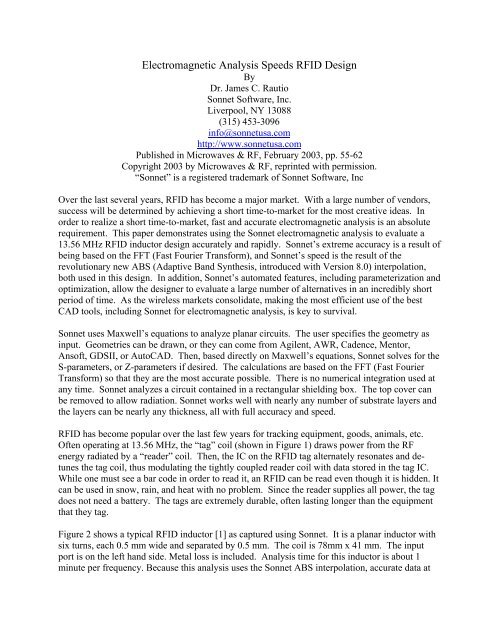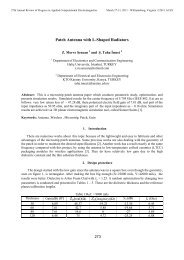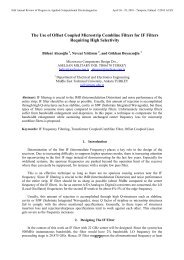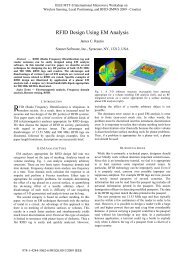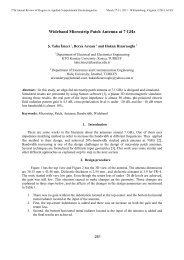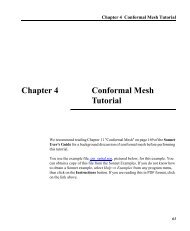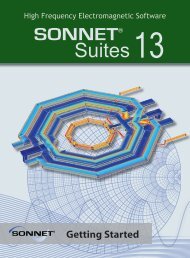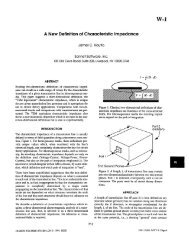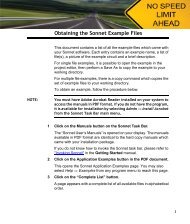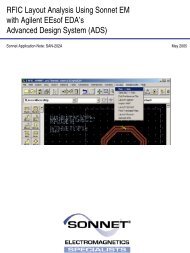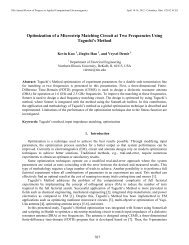Electromagnetic Analysis Speeds RFID Design - Sonnet Software
Electromagnetic Analysis Speeds RFID Design - Sonnet Software
Electromagnetic Analysis Speeds RFID Design - Sonnet Software
- No tags were found...
Create successful ePaper yourself
Turn your PDF publications into a flip-book with our unique Google optimized e-Paper software.
<strong>Electromagnetic</strong> <strong>Analysis</strong> <strong>Speeds</strong> <strong>RFID</strong> <strong>Design</strong>ByDr. James C. Rautio<strong>Sonnet</strong> <strong>Software</strong>, Inc.Liverpool, NY 13088(315) 453-3096info@sonnetusa.comhttp://www.sonnetusa.comPublished in Microwaves & RF, February 2003, pp. 55-62Copyright 2003 by Microwaves & RF, reprinted with permission.“<strong>Sonnet</strong>” is a registered trademark of <strong>Sonnet</strong> <strong>Software</strong>, IncOver the last several years, <strong>RFID</strong> has become a major market. With a large number of vendors,success will be determined by achieving a short time-to-market for the most creative ideas. Inorder to realize a short time-to-market, fast and accurate electromagnetic analysis is an absoluterequirement. This paper demonstrates using the <strong>Sonnet</strong> electromagnetic analysis to evaluate a13.56 MHz <strong>RFID</strong> inductor design accurately and rapidly. <strong>Sonnet</strong>’s extreme accuracy is a result ofbeing based on the FFT (Fast Fourier Transform), and <strong>Sonnet</strong>’s speed is the result of therevolutionary new ABS (Adaptive Band Synthesis, introduced with Version 8.0) interpolation,both used in this design. In addition, <strong>Sonnet</strong>’s automated features, including parameterization andoptimization, allow the designer to evaluate a large number of alternatives in an incredibly shortperiod of time. As the wireless markets consolidate, making the most efficient use of the bestCAD tools, including <strong>Sonnet</strong> for electromagnetic analysis, is key to survival.<strong>Sonnet</strong> uses Maxwell’s equations to analyze planar circuits. The user specifies the geometry asinput. Geometries can be drawn, or they can come from Agilent, AWR, Cadence, Mentor,Ansoft, GDSII, or AutoCAD. Then, based directly on Maxwell’s equations, <strong>Sonnet</strong> solves for theS-parameters, or Z-parameters if desired. The calculations are based on the FFT (Fast FourierTransform) so that they are the most accurate possible. There is no numerical integration used atany time. <strong>Sonnet</strong> analyzes a circuit contained in a rectangular shielding box. The top cover canbe removed to allow radiation. <strong>Sonnet</strong> works well with nearly any number of substrate layers andthe layers can be nearly any thickness, all with full accuracy and speed.<strong>RFID</strong> has become popular over the last few years for tracking equipment, goods, animals, etc.Often operating at 13.56 MHz, the “tag” coil (shown in Figure 1) draws power from the RFenergy radiated by a “reader” coil. Then, the IC on the <strong>RFID</strong> tag alternately resonates and detunesthe tag coil, thus modulating the tightly coupled reader coil with data stored in the tag IC.While one must see a bar code in order to read it, an <strong>RFID</strong> can be read even though it is hidden. Itcan be used in snow, rain, and heat with no problem. Since the reader supplies all power, the tagdoes not need a battery. The tags are extremely durable, often lasting longer than the equipmentthat they tag.Figure 2 shows a typical <strong>RFID</strong> inductor [1] as captured using <strong>Sonnet</strong>. It is a planar inductor withsix turns, each 0.5 mm wide and separated by 0.5 mm. The coil is 78mm x 41 mm. The inputport is on the left hand side. Metal loss is included. <strong>Analysis</strong> time for this inductor is about 1minute per frequency. Because this analysis uses the <strong>Sonnet</strong> ABS interpolation, accurate data at
300 frequencies is calculated from electromagnetic analysis at only four frequencies. This entireanalysis takes only four minutes.By using the <strong>Sonnet</strong> Option “<strong>Analysis</strong>->Optional files->Add SPICE”, a lumped equivalent circuitis generated [2]. The output, shown in Table 1, is in SPICE format. <strong>Analysis</strong> at two frequenciesis required. To check the SPICE results, it is always good to use <strong>Sonnet</strong> to create two SPICEfiles. In this case, the first SPICE file is generated from data at 12.1 and 13.3 MHz. The result is:C1 1 0 1.09pfL1 1 2 4523nhRL1 2 0 1.71The second SPICE file is generated from data at 13.3 and 14.65 MHz with the following result:C1 1 0 1.11pfL1 1 2 4521nhRL1 2 0 1.77Both analyses give almost exactly the same answer. This means that the SPICE model generatedby <strong>Sonnet</strong> is working well for this circuit. We shall use this SPICE model to design the rest of the<strong>RFID</strong> circuit.In Figure 3, the <strong>Sonnet</strong> SPICE model is on the left. The <strong>Sonnet</strong> model includes a resistor in serieswith the inductor. This is most realistic. However, for some calculations, we would also like toknow what the equivalent parallel resistance is. This is easily calculated using the equation in thefigure. For a series resistance of 1.8 Ohms, the equivalent parallel resistance is 82.4 kOhms.From the <strong>Sonnet</strong> generated SPICE model, the capacitance is 1.1 pF and the inductance is 4523nH.The <strong>RFID</strong> IC we wish to use has a total of 23.5 pF of internal capacitance. The inductor, ascalculated by the <strong>Sonnet</strong> SPICE model, already has 1.1 pF of capacitance. In order to make a4523 nH coil resonant at 13.56 MHz, we need a total of 30.5 pF. Thus, we must add an externalcapacitor of 5.9 pF to tune the inductor to 13.56 MHz when it is connected to the <strong>RFID</strong> IC.Figure 4 shows a schematic of the entire tag coil circuit. The <strong>RFID</strong> IC is on the left. As specifiedby the manufacturer, it has both an internal capacitance and resistance. The external 5.9 pFcapacitor is in the center. The inductor model generated by <strong>Sonnet</strong> is on the right.It is useful to calculate the total impedance of the resonant circuit at resonance. This is simply theparallel combination of the <strong>RFID</strong> IC internal resistance of 25 kOhms with the 82.4 kOhmsequivalent parallel resistance of the coil. The total resistance is about 19 kOhms. This is theimpedance that the <strong>RFID</strong> IC sees at resonance.The circuit of Figure 3 is easily analyzed using any nodal circuit simulator. There is even asimple nodal analysis available with <strong>Sonnet</strong>. The <strong>Sonnet</strong> netlist for this circuit [2] is as follows:
frequency, but, for this case, that is no problem. The result using this port is almost the same asbefore.Special metal types are added by using “Circuit->Metal Types->Add”. The capacitor is a“General” metal type with all values equal to zero except for XDC. Since there is no longer anytransmission line to remove, and the port discontinuity is very small, we can turn de-embeddingoff (<strong>Analysis</strong>->Setup->Advanced->uncheck de-embed).How does coupling vary with the offset between the reader coil and the tag coil? To check this[6], we added a second inductor 50 mm above the first one, Figure 8. We also made the boxcontaining the circuit bigger. This is important because we do not want the inductor to get tooclose to the sidewalls.For the analysis, we varied the offset from 0 mm to 160 mm in steps of 40 mm. The readerinductor is shown above with an offset of 40 mm. <strong>Sonnet</strong> is set up to automatically calculate afull frequency sweep for each of the five reader coil positions. Each frequency sweep generatesabout 300 data points. Because the <strong>Sonnet</strong> ABS interpolation is used, analysis at only fourfrequencies is needed to generate data at all 300 frequencies.After completing the <strong>Sonnet</strong> analysis, we can determine how much voltage is generated at the tagcoil (port 1) when we put current into the reader coil (port 2). This is just the value of Z 12 . Forexample, if Z 12 is 9000 Ohms, then 1 mA into the reader coil generates 9 volts on the tag coil port.Since the <strong>Sonnet</strong> layout includes the internal resistance of the <strong>RFID</strong> IC, a full 9 volts will appearat the <strong>RFID</strong> IC to be used for operation.Figure 9 shows that for both 0 mm offset and for 40 mm offset, the value of Z 12 is just under 9000Ohms. Thus, the <strong>RFID</strong> IC will have just under 9 Volts to operate for every 1 mA of current goinginto the reader coil.The value of Z 12 drops off quickly for 80 mm or more offset. At this location, the reader coil hasjust passed beyond the edge of the tag coil. For large offsets, the tag coil gets only about 2 Voltsfor every 1 mA flowing into the reader coil.When the tag coil gets enough power, it operates by repeatedly tuning and de-tuning the coil toresonance at 13.56 MHz, Figure 10 (from [7]). When the tag resonant circuit is de-tuned, the tagcoil has no effect on the impedance of the reader coil. When the tag coil is resonant, it couplesstrongly to the reader coil and changes the reader coil impedance. It is this change in impedancethat is read by the reader.When the tag coil is resonant, the input impedance of the reader coil is Z 22 . When the tag coil isde-tuned, the tag coil has no effect on the reader coil. In this case, the reader coil impedance isthe same as if there is no tag coil there at all. In Figure 11, we see this difference directly. Bysensing this change in coil impedance, the reader can read the information sent by the tag coil.When there is a large offset between the reader coil and tag coil, the tag coil has no effect on thereader coil. The reader coil has an input impedance of about 18000 Ohms. When the tag coil is
de-tuned by the <strong>RFID</strong> IC, the tag coil will also have no effect on the reader coil. In this case, thereader coil input impedance will also be 18000 Ohms, regardless of where the tag coil is located.When there is 0 mm offset between the tag coil and the reader coil, the resonant tag coil couplesstrongly to the reader coil. The reader coil input impedance then drops to about 4000 Ohms. Ifthe offset is 40 mm, the resonant tag coil changes the reader coil input impedance to about 8000Ohms. At 80 mm offset and above, there is little change. At 80 mm offset, the reader coil hasmoved so there is no overlap with the tag coil. There is also almost no coupling. Repeating thisanalysis using a reader coil two times bigger also shows that there is little coupling when there islittle overlap between the coils.In conclusion, we have shown how <strong>Sonnet</strong>’s EM and nodal analyses can be used to easily analyze<strong>RFID</strong> coils. We precisely calculated the additional capacitance required. We also included metalloss and evaluated how the coupling between the <strong>RFID</strong> reader and tag change as the reader coil ismoved.We have also demonstrated the use of <strong>Sonnet</strong>’s new ABS interpolation. ABS generates accurateresults at over 300 frequencies after a full EM analysis at just a few frequencies. In fact all theEM analyses in this presentation were done with only four analyses per complete frequencysweep.References[1] File: <strong>RFID</strong>_1.son. Copies of this file, and all others in this paper, can be obtained athttp://www.sonnetusa.com.[2] File: <strong>RFID</strong>_1_net.son.[3] <strong>Sonnet</strong>Lite can be downloaded from http://www.sonnetusa.com.[4] <strong>Sonnet</strong> User’s Guide, Vol. 1. Chapter 21. Circuit in files <strong>RFID</strong>_sense_25.son and<strong>RFID</strong>_sense_35.son.[5] File <strong>RFID</strong>_2.son.[6] File: <strong>RFID</strong>_3.son.[7] “microID 13.56 MHz <strong>RFID</strong> System <strong>Design</strong> Guide”, http://www.microchip.com.
<strong>Sonnet</strong> ModelEquivalent ModelR S =1.8ΩR P =82.4kΩR = R (1 +PSX2S/ R2S)Figure 3: On the left is the SPICE lumped circuit synthesized by <strong>Sonnet</strong>. On the right isan equivalent lumped circuit useful for certain calculations. See text for inductance andcapacitance.IC ModelC=23.5pFR P =25kΩC EXT5.9pFInductor ModelC=1.1pFL=4523nHR P =82.4kΩFigure 4. Equivalent circuit of the entire tag coil circuit, including the <strong>RFID</strong> IC, theexternal resonating capacitor, and the tag coil itself.
ImagMagFigure 5. <strong>Analysis</strong> of the complete <strong>RFID</strong> circuit shows the expected high impedance(“mag” curve) at the 13.56 MHz resonance (frequency where the imaginary part is zero).
B-Field25 mm above coilE-FieldFigure 6. The tangential E-field as calculated by <strong>Sonnet</strong>, 25 mm (left) and 35 mm (right)above the coil as calculated by <strong>Sonnet</strong>. <strong>Sonnet</strong> does not directly plot B-field, howeverthe B-field “curls” around the E-field as illustrated here on the right.
RGNDCFigure 7. An internal port can be used for a faster analysis. The lumped components canbe included by modifying the surface impedances of small squares of metal.
Figure 8. Two inductors can be repeatedly analyzed as a function of their offset. Herethe tag coil is shown in dashed lines and the reader coil in solid lines. They are offsetvertically by 50 mm. The horizontal offset, set to 40 mm, is indicated in the figure.Offset:0 mm40 mm80Figure 9. Coupling between the two inductors is strong until the offset exceeds 80 mm.
Tag coil resonantTag coil de-tunedFigure 10. The <strong>RFID</strong> IC operates by alternately tuning and de-tuning the tag coil forresonance at 13.56 MHz.
Tag coildetunedTag coilresonant,but offset:80 mm40 mm0 mmFigure 11. Input impedance of the reader coil when the tag coil is tuned to resonance.When the tag coil is de-tuned, there is no coupling.


